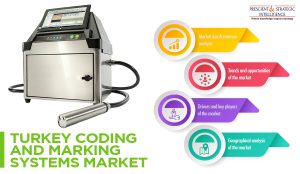As per numerous reports, 20% of the contribution to the Turkish GDP is made by the food and beverage industry. Moreover, the government plans to significantly boost its food output by 2023, to take the industry’s contribution to the GDP to $150 billion. This would mean heavy investments in farming, food processing facilities, warehouses, and logistics networks. This translates into an enormous growth potential for the Turkish coding and marking systems market, as these systems are a necessity at food processing factories.

Food and beverage companies are mandated to provide important information, including the product ingredients, manufacturing and expiry dates, nutrient profile, batch number, allergen warning, and manufacturer details, on both the primary and secondary food packaging. With the increasing awareness on the effect food has on the body, people have become conscious of what they eat. Therefore, the government has implemented strong mandates for companies to provide all this information, for which coding and marking systems are required.
Already in 2017, the country was home to 41,000 registered food and beverage companies, and with the government making efforts to boost production and deploy advanced technology, together with the rising population, companies from overseas are establishing their production plants here. A key idea of the government behind these efforts is to increase food exports, which already outvalue the imports to Turkey. Moreover, around 50% of its population is less than 30 years of age, which is why the popularity of international cuisines has been constantly rising here.
Another key industry from the point of the usage of coding and marking systems is pharmaceuticals. Since the body is even more sensitive to drugs than food, people need to know exactly what they are consuming. Moreover, all drugs have a set expiry, after which they end up doing more harm than good. That is why pharmaceutical companies are regulated strongly in the form of production environment guidelines and mandates for providing all drug-related information on the packaging.
As per the Pharmaceutical Manufacturers Association of Turkey, there were 680 entities engaged in the pharma business in the country in 2020. According to its 2020 Turkish Pharmaceutical Industry Report, the sale of pharmaceuticals and medicinal products rose by 19.9% in 2020, to TRY 52.8 billion. Of this, TRY 47.9 billion revenue was generated by the sale of pharma products alone, rising by 17.7% from 2019. A key reason for this growth was the introduction of 310 new drugs, which reflects a huge demand for coding and marking systems.
Ultimately, the growth of both the food and beverage and pharmaceutical industries and, in turn, of the Turkish coding and marking systems market, can be linked to the rise in its population. As per the World Bank, the Turkish population rose from around 27.4 million in 1960 to 84.3 million in 2020. This naturally means more mouths to feed, which has been driving the demand for food and beverages. This is also means more people with all kinds of medical issues, thereby propelling the consumption of prescription and over-the-counter drugs.
